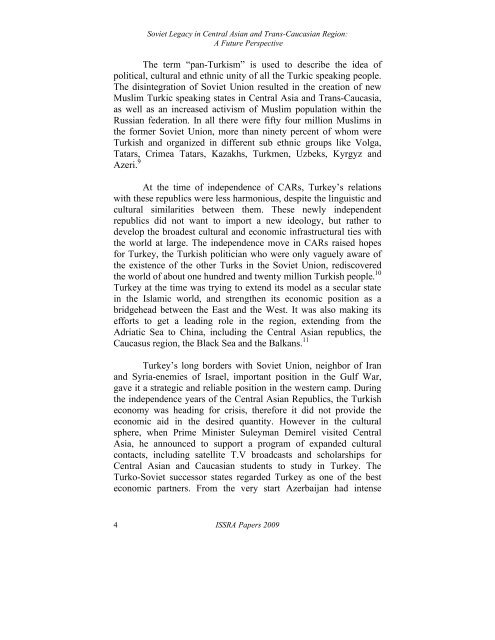issra papers vol i, 2009 - National Defence University
issra papers vol i, 2009 - National Defence University
issra papers vol i, 2009 - National Defence University
You also want an ePaper? Increase the reach of your titles
YUMPU automatically turns print PDFs into web optimized ePapers that Google loves.
Soviet Legacy in Central Asian and Trans-Caucasian Region:<br />
A Future Perspective<br />
The term “pan-Turkism” is used to describe the idea of<br />
political, cultural and ethnic unity of all the Turkic speaking people.<br />
The disintegration of Soviet Union resulted in the creation of new<br />
Muslim Turkic speaking states in Central Asia and Trans-Caucasia,<br />
as well as an increased activism of Muslim population within the<br />
Russian federation. In all there were fifty four million Muslims in<br />
the former Soviet Union, more than ninety percent of whom were<br />
Turkish and organized in different sub ethnic groups like Volga,<br />
Tatars, Crimea Tatars, Kazakhs, Turkmen, Uzbeks, Kyrgyz and<br />
Azeri. 9 At the time of independence of CARs, Turkey’s relations<br />
with these republics were less harmonious, despite the linguistic and<br />
cultural similarities between them. These newly independent<br />
republics did not want to import a new ideology, but rather to<br />
develop the broadest cultural and economic infrastructural ties with<br />
the world at large. The independence move in CARs raised hopes<br />
for Turkey, the Turkish politician who were only vaguely aware of<br />
the existence of the other Turks in the Soviet Union, rediscovered<br />
the world of about one hundred and twenty million Turkish people. 10<br />
Turkey at the time was trying to extend its model as a secular state<br />
in the Islamic world, and strengthen its economic position as a<br />
bridgehead between the East and the West. It was also making its<br />
efforts to get a leading role in the region, extending from the<br />
Adriatic Sea to China, including the Central Asian republics, the<br />
Caucasus region, the Black Sea and the Balkans. 11<br />
Turkey’s long borders with Soviet Union, neighbor of Iran<br />
and Syria-enemies of Israel, important position in the Gulf War,<br />
gave it a strategic and reliable position in the western camp. During<br />
the independence years of the Central Asian Republics, the Turkish<br />
economy was heading for crisis, therefore it did not provide the<br />
economic aid in the desired quantity. However in the cultural<br />
sphere, when Prime Minister Suleyman Demirel visited Central<br />
Asia, he announced to support a program of expanded cultural<br />
contacts, including satellite T.V broadcasts and scholarships for<br />
Central Asian and Caucasian students to study in Turkey. The<br />
Turko-Soviet successor states regarded Turkey as one of the best<br />
economic partners. From the very start Azerbaijan had intense<br />
4<br />
ISSRA Papers <strong>2009</strong>

















